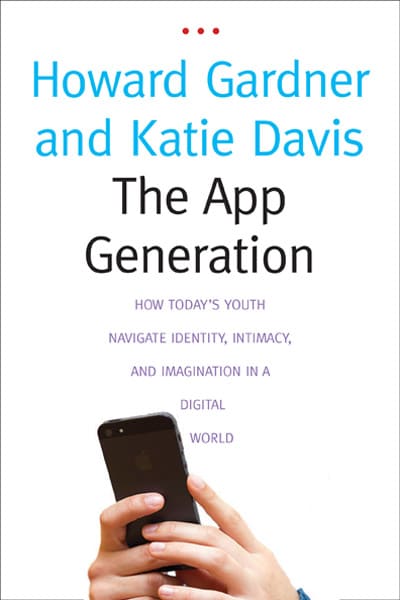Howard Gardner and Katie Davis’ new book, The App Generation: How Today’s Youth Navigate Identity, Intimacy, and Imagination in a Digital World (Yale University Press), out this month, is a fun mix of old and new. The book provides an extensive review of the literature on how new technologies are changing children’s lives. The authors compare their own experiences with technology to those of the current generation. Gardner and Davis also situate their discussion in the dustier nooks and crannies of western philosophy and literature, invoking thinkers and writers like McLuhan and Flaubert to explain human beings and how we make meaning. For anyone convinced that valuable insights predated the information age, that Paris in the 1850s can tell us as much about human nature as Silicon Valley in the 1990s, the book provides some especially charming discussions.
The App Generation touches on a vast array of youth development research and media studies, sorting the findings into what the authors call the “three I’s”: identity, intimacy, and imagination. In addition, Gardner and Davis add their own insights from a series of research projects and focus groups they’ve conducted to diagnose the effects that apps have on young people today, compared to prior generations.
They conclude that apps can go one of two ways: “dependent” or “enabling.” Dependent apps dictate one’s course of action, hence inculcating dependence. Enabling apps open up one’s possible courses of action, thereby enabling the user to explore and create. These categories essentially correspond with two brands of psychology that are often discussed in education—behavioralism and constructivism. Behavioralists believe that life is constructed of habits that are taught by a system of rewards, whereas constructivists believe that views, skills, and habits are constructed based on the individual’s own exploration of the world. Apps can serve as a tool for either camp: shaping young people’s behaviors with the precision of a behavioralist or opening up opportunities for exploration and stepping aside, as a constructivist is apt to do.
As you might expect, apps are not, as a rule, inherently dependent or enabling for young users today. Some apps are unlocking the possibility of exercising creativity and forging close connections while others appear to be shutting down or distorting development. If Facebook’s “about me” categories are too narrow or if the audience is too broad, the technology risks encouraging a limited, highly-curated portrait of the self. How students use apps also matters: online forums that connect youth to others with similar interests who are otherwise hard to reach may be generating new forms of intimacy. Thus, both the architecture of a given app and how young people use it will have implications for how much it opens up or closes off developing a clear sense of self, connections to others, and new creative pursuits.
Against the backdrop of this comparison, there is an underdeveloped story of disruptive innovation. As the authors describe the world of apps, they note that “barriers of time, money, and skill are low, expanding which persons can call themselves creators and what they may be able to create.” This is precisely the path that disruptive innovations chart, offering simpler, more affordable, more accessible technologies to wide swaths of nonconsumers. This seems more significant a fact than the book is able to tackle, particularly because Gardner and Davis focus their research primarily on more affluent youth. The authors’ hesitations about the possible negative byproducts of “dependent” apps may eclipse the compelling story about expanding access to technology that disruptive innovations bring about. Danger may of course be a tradeoff. Ford’s Model T meant that more cars were on the road, and thus the likelihood of being in a car accident went up. But the Model T’s cheaper price tag and functionalities also meant that many more people could own cars and enjoy the personal and professional flexibility that came with it. The App Generation is not a gloom and doom portrait of technology, but the authors’ warnings about app dependence echo more loudly, in some sections, than the important story about widespread access to information and creative platforms that were otherwise locked in ivory towers for previous generations.
The task Gardner and Davis set out for themselves is ambitious: not only do they attempt to describe the effects of new technology in the uncontrolled experiment of all of youth culture today, but they attempt to synthesize and analyze a generation that is still emerging. They are, in effect, writing a living history. With that, of course, comes the inherent messiness of not being able to say where this is all headed. Because they can only compare this generation to those that came before, the book at times come off as reactionary: longing for an era when family and work were less mediated experiences, when families would interact face-to-face rather than over text message. But nostalgia aside, the book is a worthwhile read for those of us pondering the power of technology in education. It’s a reminder that technology is not just a growing classroom tool, but rather an inevitable part of young people’s sense of self and the world around them. We often write about the potential to personalize education, but fewer people in education are unpacking the changing sense of personhood within personalized technology. The App Generation is a great starting point for that emerging debate and vital consideration.


